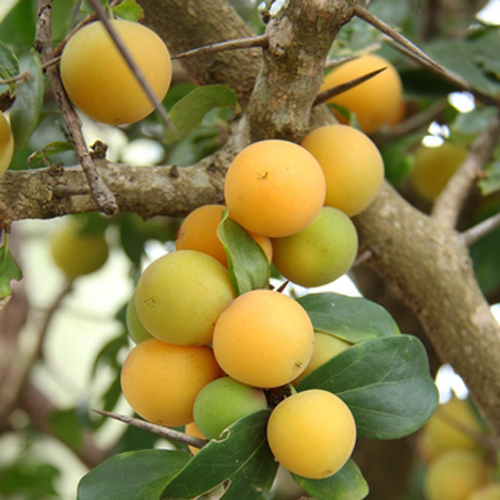Test Edibles Layout

Arbutus Andrachne (Ericacées)
Greek strawberry tree / Arbousier de Chypre
Origin/Origine: Greece, Asia minor / Grèce, Asie mineure
Hardiness/Rusticité: -12 to/à -15
Watering/Besoin en Eau: 5
Description: Height: 6m, spread: 3m. Evergreen. Young shoots are bronze coloured. Beautiful red/orange bark which peels off from the trunk. White flowers from February to April.
Description: Hauteur : 6 m, largeur : 3 m. Persistant. Les jeunes pousses prennent des teintes bronze. Remarquable écorce rouge-orangé, s’exfoliant sur le tronc. Fleur blanche de février à avril.
Cultivation: Well-drained soil, tolerates alkalinity, sun or part shade, copes with root competition on the edge of pine or oak woods.
Culture: Sol bien drainé, supporte bien le calcaire, au soleil ou à mi-ombre, supporte bien la concurrence racinaire en lisière de bois de pins ou de chênes.
Harvesting and uses of the fruit: The fruits are similar to those of A.unedo.
Fruit / Utilisation / Consommation / Récolte: Fruit semblable à celui de A. unedo
Arbutus unedo (Ericacées)
Strawberry tree / Arbre à fraises

Origin/Origine: Greece, Asia minor / Grèce, Asie mineure
Hardiness/Rusticité: -12 to/à -15
Watering/Besoin en Eau: 5
Description: Height : 5m or more. Evergreen. White flowers in October/November.
Description: Hauteur : 5 m et plus. Persistant. Floraison blanche en octobre-novembre.
Cultivation: Sun or part shade. Tolerates alkaline soils and root competition on the edge of pine or oak woods.
Culture: Soleil ou mi-ombre, supporte le calcaire, supporte bien la concurrence racinaire en lisière de bois de pins ou de chênes.
Harvesting and uses of the fruit: Round, red, granular fruit, 2-3 cm diameter, containing around 20 hard, dark seeds, which are attractive to birds. The fruits ripen in October to December the year after flowering. Eat raw or use to make a jelly. The Latin name, ‘unedo’ means one only needs to eat one, either because the fruit is delicious, or because the flavour is uninteresting. The skin has a slightly granular texture and the flesh is similar to a tropical fruit, with a delicate flavour which may be appreciated by people with sensitive taste buds. The fruit has a 20% sugar content and can be used to make nourishing jams and jellies. When fully ripe, the fruit falls from the tree, and it is therefore advisable to surround it with grass in order to cushion the fruit’s fall.
Fruit / Utilisation / Consommation / Récolte: Fruit rouge et arrondi, granuleux (2-3 cm diamètre), contenant une vingtaine de graines dures et foncées, attractifs pour les oiseaux, d’octobre à décembre (mûrissant un an après floraison). Bons crus ou cuits en gelée. Doux mais insipide.. Le nom latin «unedo» signifie «je mange une (seule)». Un rapport dit que le fruit est tellement délicieux qu’une personne a seulement besoin d’en manger un. Il possède une peau légèrement granuleuse, mais le fruit lui-même a la texture d’un fruit tropical luxuriant et possède une agréable saveur délicate. Pour les personnes ayant des papilles sensibles, c’est un fruit qui peut être apprécié. Le fruit contient environ 20% de sucres et peut être utilisé pour faire de délicieuses et nourrissantes confitures et conserves. Il est mûr en novembre/décembre et est d’environ 15 mm de diamètre. Lorsqu’il sera pleinement mûr, il tombe de l’arbre et il est donc conseillé de cultiver la plante dans l’herbe afin d’amortir la chute du fruit

Diospyros kaki (Ebénacées)
Persimmon or Kaki / Plaqueminier
Origin/Origine: China / Chine
Hardiness/Rusticité: -12 to/à -15
Watering/Besoin en Eau: Medium. Drought tolerant/Moyen. Supporte la sécheresse
Description: Height 6m. Deciduous shrub. Yellow-green flowers in June.
Description: Hauteur 6m. Arbuste caduc. Fleur jaune-verdâtre en juin.
Cultivation: Sun, but prefers cool ground.
Culture: Soleil. Préfère un sol frais.
Harvesting and uses of the fruit: The fruit mature from October to November, taking on a bright orange colour. They remain hard until after leaf fall. The flavour is a little tart due to the presence of tannins but they are rich in sugar, Vitamin C , beta-carotene, potassium, calcium, magnesium and various trace elements. Do not harvest them until after a light frost, the fruit becoming edible only when slightly over-ripe. The cultivar ‘Fuyu’ produces fruit which can be consumed quite early in the season because its firm orange flesh is sweet and not too astringent.
Fruit / Utilisation / Consommation / Récolte: Les fruits murissent d’octobre à novembre en prenant une teinte orange vif. Ils restent très tard après la chute des feuilles. Leur saveur est un peu âcre en raison de la présence de tannins mais ils sont riches en sucres, vitamine C, provitamine A, Potassium, Calcium, Magnésium et divers oligoéléments. Ils ne se récoltent pas avant la mi-novembre. Les fruits ne sont consommables que presque blets, après le passage d’une petite gelée. Le cultivar ‘Fuyu’ produit des fruits qui peuvent être consommés assez tôt en saison, car leur chair orangée est ferme, sucrée et peu astringente.

Dovyalis caffra (Salicaceae)
Kei apple / Pomme cafre
Origin/Origine: South Africa / Afrique du sud
Hardiness/Rusticité: -6°C for short periods / -6°C sur de courtes périodes
Watering/Besoin en Eau: Low / Faible
Description: Height 3 – 6m. Dioecious (*3) thorny shrub. Discreet yellow flowers. There are examples of this shrub in the botanical garden of Montpellier.
Description: Hauteur 3 à 6m. Arbuste épineux dioïque. Floraison discrète jaune. On peut en voir au jardin des plantes de Montpellier.
Cultivation: Sunny position in well-drained, rich and fertile soil.
Culture: Soleil. Sol fertile, humifère et surtout bien drainé.
Harvesting and uses of the fruit: RounGlobular fruit in August-September (3 cm diameter)with a velvety but bitter orange skin, which turns brownish-purple when ripe. The purple-red pulp is tangy and juicy.
Fruit / UtilFruits en août-septembre, globuleux (3 cm de diamètre) à la peau orange fine et veloutée mais amère, virant au pourpre marron à maturité contenant une pulpe d’un rouge pourpré acidulée et juteuse.
![]()
